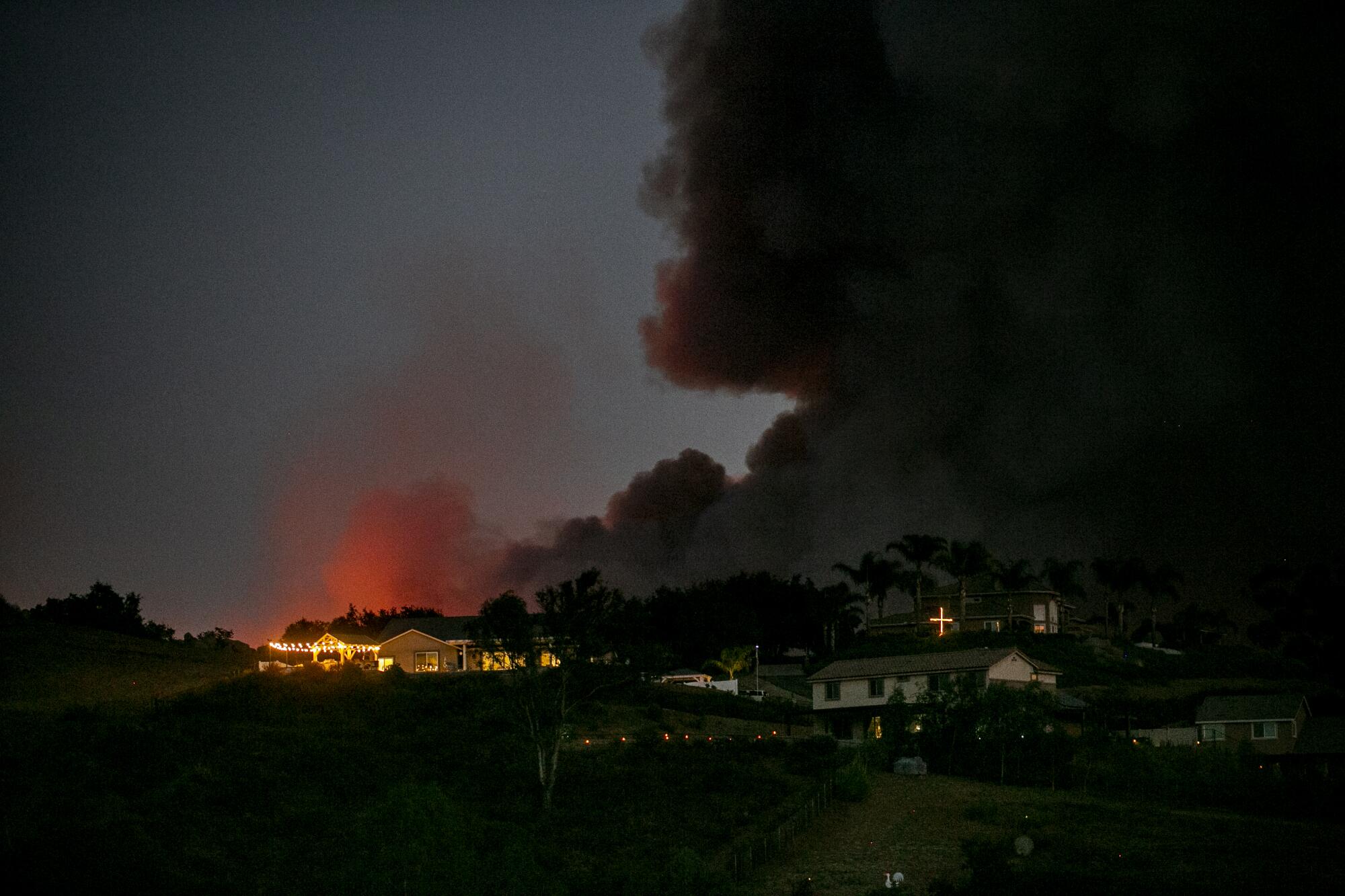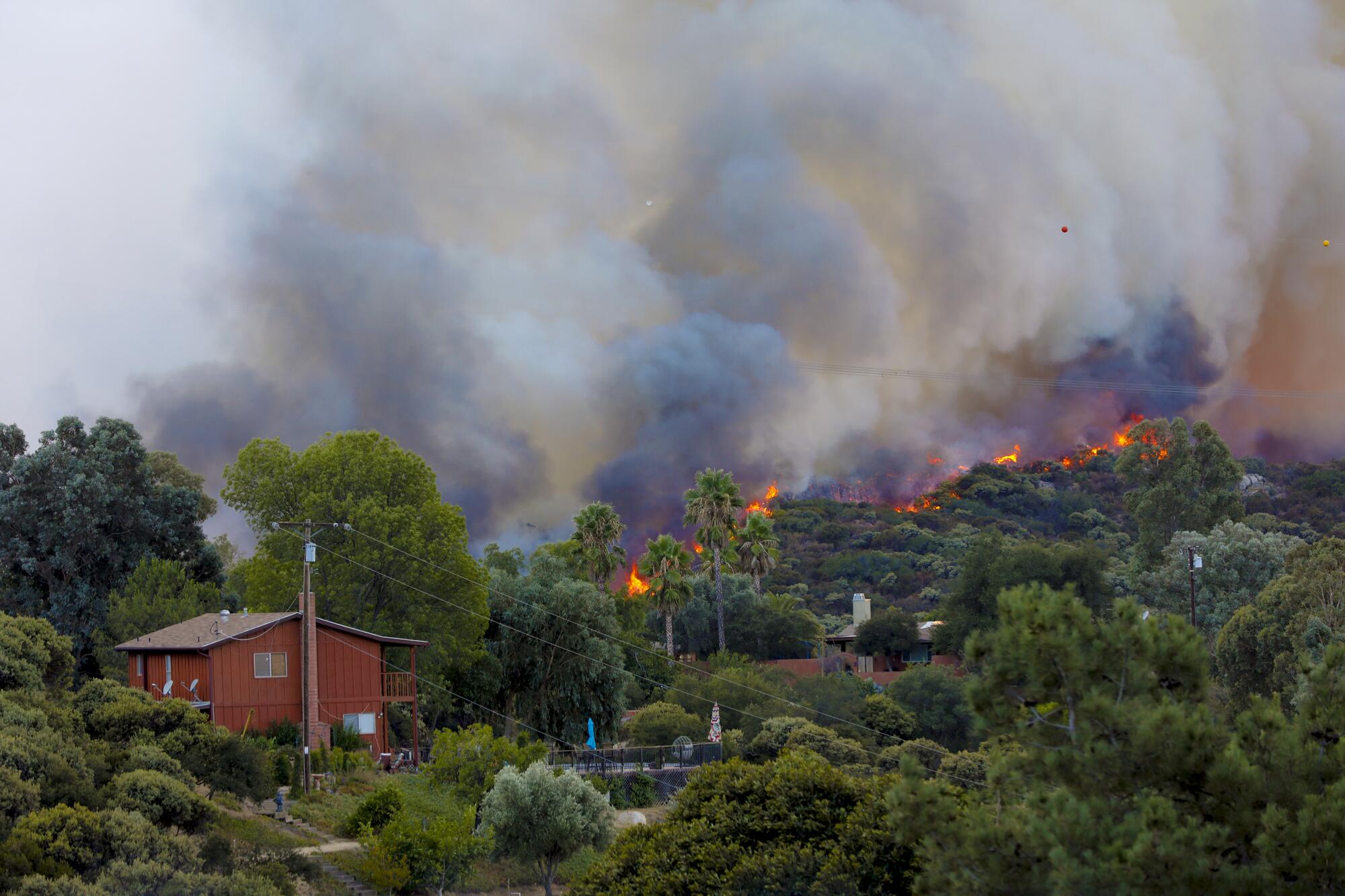
- Share via
San Diego — San Diego County leaders, for decades, approved large housing projects across the region’s rural landscape covered in highly flammable chaparral and grasslands.
Now, after years of court battles challenging such developments, large-scale backcountry building may be at an end.
This story is for subscribers
We offer subscribers exclusive access to our best journalism.
Thank you for your support.
Under pressure from the state, the county Board of Supervisors recently adopted a long-awaited suite of policies that developers and conservation groups agree will make it nearly impossible to build in far-flung parts of the county.
However, the new approach will limit opportunities for new home construction at a time when short supply coupled with real estate speculation have crushed first-time homebuyers and others.
“Let me be clear,” said Matthew Adams, vice president of the Building Industry Assn. of San Diego County. “This is going to have a devastating impact on our ability to produce middle-income or market-rate housing in vast portions of the unincorporated area.”
Environmentalists have argued that any lost housing would be a small price to pay for preventing planet-warming emissions from grueling car commutes and protecting people from devastating wildfires.
“It’s crazy to keep building houses where we know they’re going to burn to the ground,” said David Grubb of the San Diego chapter of the Sierra Club.
Backed by the state attorney general’s office, local conservation groups have over the last several years won one decisive legal victory after another, blocking thousands of homes from being built in high-fire areas. Elected leaders are now hoping to put an end to the legal wrangling, which included a failed attempt by the county to let developers buy carbon offsets as a way to comply with state environmental laws.

“We need to stop spending years of our life in litigation on things where we will lose,” County Supervisor Chair Nathan Fletcher said at a recent public hearing on the issue.
As a result, the board recently approved new rules that put developers on the hook for new driving created by housing projects in the unincorporated county. The farther a project is from a job center, grocery store and other key destinations, the greater its projected environmental footprint.
That means home builders will likely have to forgo such projects or somehow offset those tailpipe emissions, which are measured in vehicle miles traveled, or VMT. The county is still working out the details on what so-called mitigation could entail, but it’ll likely focus on a fee used to fund new transit projects.

The building industry expects that it’ll cost about $10,000 a mile based on talks with the county. Adams, with the local builders association, said that means many projects simply won’t pencil out.
“It’s not financially feasible,” he said. “On the low end, you’ll see fees as much as $50,000 per unit just to comply with this mitigation measure.”
The Sierra Club and other green groups could still challenge such projects based on the threat of wildfire, but officials hope the new rules will encourage the types of housing developments likely to stand up in court.
County officials have also created a carveout for developers, waiving the new VMT rules in areas they say are likely to be served by transit in the future. These so-called infill communities are located in places such as Spring Valley, Lakeside and just outside of Escondido and San Marcos.
Environmental groups don’t like the idea and are threatening to challenge the move in court. They say such areas are exactly where developer money for new transit and pedestrian upgrades could make the most difference.
San Diego County targets neighborhoods for new housing
One such project, Escondido Estates, envisions 20 single-family homes on half-acre lots within 3 miles of a transit center. Another project, Greenhills Ranch, would build 63 homes in Lakeside in a high-fire area.
“With just a tiny bit of mitigation, they could get to the threshold,” said Livia Borak, a lawyer for Coast Law Group representing the Cleveland National Forest Foundation. “They don’t need this infill exemption.”
County officials have argued that the urgency for new housing outweighs any downsides to giving developers a free pass on VMT restriction in these relatively dense communities.
“It’s a difficult thing,” Fletcher said. “When you acknowledge that we must simultaneously reduce greenhouse gas emissions, and we must build more housing, it requires a fundamentally different approach.”
The new rules are the result of a landmark state law that directs jurisdictions to shift from analyzing a housing project’s impact on traffic congestion to vehicle miles traveled. The Legislature passed a law in 2013 mandating that local governments embrace the switch in an effort to discourage suburban sprawl and make it easier to build in already congested urban areas.
Nearly a decade later, jurisdictions across the state are only now starting to work out the kinks. A key point of contention has been setting a benchmark for what counts as too much driving.
San Diegans travel an average of about 20 miles a day in their cars, according to countywide data. The state has said anything over 85% of such a regional average should be considered a significant impact requiring mitigation.
However, several jurisdictions have attempted to sidestep this by adopting rules that use a higher average associated with only their unincorporated territory. That includes the counties of Santa Barbara and San Bernardino.
“There are many counties that are just flagrantly flipping the bird at the state,” said Matt Baker, policy director for the Planning and Conservation League in Sacramento.
Los Angeles County tried something similar before the Governor’s Office of Planning and Research started pushing back on the tactic. Still, it’s largely up to environmental groups to challenge the approach in court, as the state’s guidance is subject to legal interpretation.
San Diego County initially tried to rely on its less-onerous unincorporated average of more than 32 miles a day. However, the Cleveland National Forest Foundation sued, and eventually the Board of Supervisors agreed to use the countywide benchmark.

Developers and at least one San Diego elected official wanted to duke out the issue in court. County Supervisor Jim Desmond said that using the more restrictive average was going to reduce the potential for building new housing in the unincorporated region by 90%.
“The VMT is really a wrench here in the ointment,” he said at a recent public hearing. “We’re having less opportunities for housing, and it’s getting more expensive.”
The county said it will need another three years to draft a blueprint outlining exactly how developers will be able to offset the impacts from new car trips. In the meantime, projects would be evaluated on an individual basis.
Affordable housing developments are exempt from the new rules, as are small projects that generate fewer than 110 daily trips. Retail developments, such as grocery stores, gas stations and restaurants, also get a pass.
The county has a target of building 6,700 new units in the unincorporated area by 2029, under its state-mandated Regional Housing Needs Assessment. It has permitted more than 2,000 homes since 2020.
More to Read
Sign up for Essential California
The most important California stories and recommendations in your inbox every morning.
You may occasionally receive promotional content from the Los Angeles Times.













